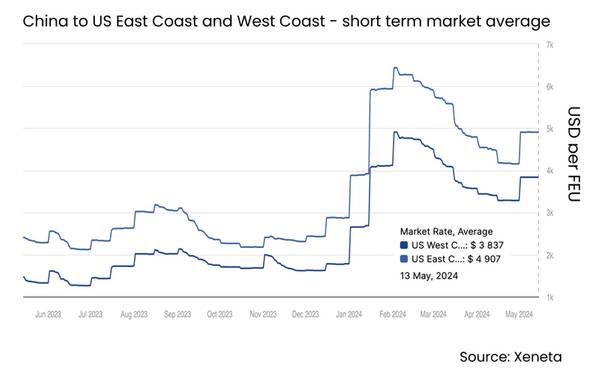
Source: Xeneta
Global supply chains are braced for further disruption and increasing costs after US President Joe Biden announced new tariffs on Chinese imports on Tuesday.
The tariffs will be imposed on a wide range of Chinese imports including semi-conductors, batteries, EVs and solar cells, with the changes staggered to come into effect between 2024 and 2026.
Peter Sand, Chief Analyst at Xeneta, said: “The new tariffs under President Biden may be a case of history repeating. If so, businesses will be braced for increasing supply chain costs and ultimately it will be US consumers who pay for it.
“Back in 2018, we saw the US under President Trump impose a wide raft of tariffs on Chinese imports. China retaliated by imposing increasing tariffs of its own, and this constant trading of blows saw ocean freight container shipping rates from China to the US West Coast increase by more than 160%.
“Rates began to fall away again towards the end of 2018 as the situation calmed, but they never returned to the same level, meaning a new status quo was established in the market at a higher cost level.”
Sand believes businesses may look to alternative supply chain routes into the US in light of the latest tariffs.
Growth in demand for container shipping imports from China into Mexico in the first quarter of 2024 had already increased by 34% compared to 12 months ago, fueling suspicions it is being used by some shippers as a ‘back door into the US’.
Sand said: “The ocean freight container market has seen incredible increases in demand from China into Mexico and the latest US tariffs could see this rapid growth continue.
“In a purely hypothetical scenario, at the current growth rate, by the year 2031 there will be more containers imported from China into Mexico than the US West Coast.
“We may also see US shippers look to import goods from nations such as Vietnam as an alternative to China – as has increasingly been the case since the 2018 tariffs hike hit the market.
“However, these are immature supply chain routes compared to the established Transpacific trade direct from China to the US West Coast. This means more complexity, more volatility and increased cost.”
The announcement of tariffs also comes at a time when the ocean freight container shipping market is being impacted by major black swan events including conflict in the Red Sea and drought in the Panama Canal.
On May 14, the average spot rate for ocean freight shipping from China to the US West Coast stood at USD 3837 per FEU (40ft shipping container), which is an increase of 162% compared to 12 months ago.
From China into the US East Coast, average spot rates have increased by more than 100% compared to 12 months ago.
Sand said: “Ocean freight shipping routes from China to the US East and Gulf Coast are still being hampered by restrictions in the Panama Canal. The next best alternative is the Suez Canal, but this isn’t an option either for the majority of shippers due to the conflict in the Red Sea.
“More red tape and complexity in supply chains is the last thing the ocean freight shipping industry needs right now.”
Sand believes much will now depend on China’s response. “There is no doubt this is an aggressive move by the US against China and, once again, we are seeing geo-politics impact global supply chains.
“The new tariffs will affect around $18 billion in annual imports, which is not a huge amount in the grand scheme of US trade, but if China responds in the same way as 2018 then we could be at the start of another spiral of escalating tariffs. That will mean yet more pain for shippers and ocean freight service providers to deal with.”





